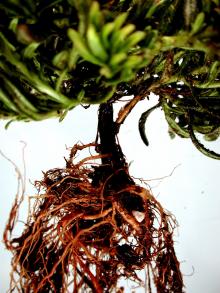See:
Greenhouse Plants, Ornamental - Black Root Rot
Cause Cause Berkeleyomyces sp. (formerly Thielaviopsis basicola) is a widely distributed root pathogen reported from at least 30 plant families. Untreated or improperly treated field soil can be a source of T. basicola if used in potted-plant culture. Most soilless media are clean; however, T. basicola spores can be in commercial peat moss and result in disease problems. The pathogen forms thick-walled chlamydospores, which can survive several years in soil. Root exudates stimulate chlamydospores to germinate in soils whose pH ranges from 5 to 8.5, and root rot tends to be more serious in plants grown in neutral and alkaline soils. Root rot also generally is more serious for plants grown in soil at 55°F to 70°F but can be severe on some plants at as high as 77°F. Disease severity tends to be worse when temperatures are not optimal for the plant, and the soil moisture-holding capacity is 70% or above for extended periods.
Symptoms Plants often are chlorotic and stunted. Several scattered branches may dieback and resemble other disease problems. Initially, roots or portions of roots killed by this pathogen are brown. These root lesions then turn black because of the abundant formation of chlamydospores on the root surface and in the root cortex.
Cultural control Fungicides do not compensate for poor sanitation or environmental controls.
- The disease is greatly reduced at pH levels below 5.5.
- Use soilless planting media. If field soil is a component of the growing medium, treat it with steam (122°F for 30 min) or chemical fumigants.
- Dispose of diseased plants and plant material promptly.
- Do not let contaminated tools or hands contact sterilized planting media.
- Keep entire propagation and growing areas clean.
- After the production cycle, remove any remaining plants and disinfect the growing area.
Chemical control There are no fungicides specifically registered for this crop. However, several fungicides such as Banrot, Medallion, Terraguard and Thiophanate-methyl-based products may be effective if not phytotoxic to the plants. Fungicides work best when used as a protectant in combination with cultural controls. Chemical control may require multiple applications. If the disease is noticed early, also treat with fungicides. This disease can be difficult to control.




